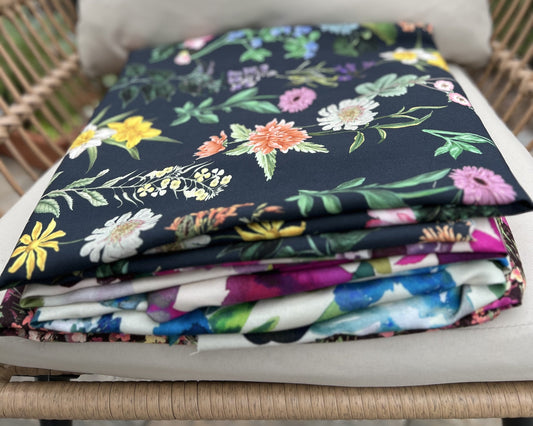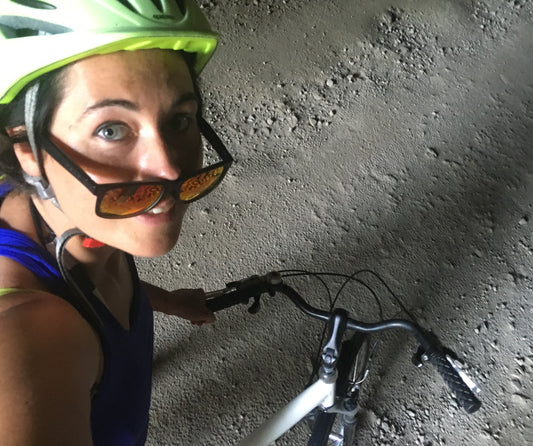This article will be a kind of pilot for a series on wool, so it seems natural that it should allay those doubts, uncertainties and fears that arise when you first think of sewing with wool.
The top 5 reactions from people who have yet to get to know and love wool are:
- "It bites!"
- "It can't be washed!"
- "The moths will eat!"
- "It's only for winter."
- "It's for a jumper."
Thus.
"Wool? It bites!"
This is a large generalisation, as they 'bite' wool varieties with high coarseness and coarse hair. Sheep come in a multitude of varieties that differ not only in appearance but also in fleece type. It is impossible not to mention fine merino, which has soft and fine hair with excellent thermal performance. When looking for the right knit or woollen fabric, we need to determine our needs and requirements. For garments intended for constant contact with the body and more specifically with the skin (especially children's skin), merino wool (also known as merino) is the best choice, as it is the softest sheep's wool. Merino sheep varieties, and even individual animals, differ in hair quality, so we will also find finer and less fine wools among them. For outer garments or lined garments, wool with lower hair qualities may be tempting, so do not rule out less fine wools.
Here we have room for a good fabric retailer to suggest the right material depending on expectations and application.
"Alergia na wełnę owczą, a dokładniej na lanolinę w niej zawartą, która może powodować podrażnienia skóry nawet przy najdelikatniejszej wełnie owczej, zasługuje na krótkie wspomnienie. W takim przypadku warto poszukać alternatywy, która często okazuje się być kaszmirem."
tzn. wełna szczególnego rodzaju kozy lub wełna alpaki. Oba włókna zawierają znikome ilości lanoliny.
And finally - let's love biting the wool. Rough wool massages the skin, improving blood circulation and thus nourishing and conditioning the skin. Let's give slightly biting wool a chance. Our skin becomes very accustomed to the stimuli it constantly receives. Who among us remembers the once popular massaging flip-flops with tabs?
Coś, co na początku przypominało chodzenie po żwirze, stało się przyjemnym masażem.
"Wool? It can't be washed!"
Często gotowe do noszenia wełniane ubrania, a zwłaszcza odzież wierzchnia, mają w przepisie pielęgnacyjnym pranie chemiczne. W ten sposób producenci często w sposób nieco przesadzony chronią się przed potencjalnymi reklamacjami wynikającymi z niewłaściwej pielęgnacji odzieży.
Kiedy szyjemy samodzielnie, mamy większe możliwości. Możemy używać wełny z obecnie popularnym wykończeniem 'superwash' do szycia lub być kuszeni do przetestowania zakupionego materiału. Aby to zrobić, należy wyciąć kawałek tkaniny o wymiarach co najmniej 10×10 cm i go wyprać. A po całkowitym wyschnięciu sprawdzamy, czy jego rozmiar lub jakość się zmieniły. Jeśli wełna zachowała swój rozmiar i strukturę, odzież można z powodzeniem wyprać.
Wełnę należy prać ręcznie lub na programie wełnianym (najlepiej najpierw przetestować swoją pralkę) używając detergentu przeznaczonego do tego celu (wełny nie należy prać w standardowych proszkach/płynach/kapsułkach do prania!).
We often dread the recommended hand washing, but completely unnecessarily. Hand-washing wool involves soaking it in water with wool detergent, then gently wrinkling it, rinsing it, squeezing (not wringing!) out excess water and letting it dry. The process is essentially low-impact, and given that wool is anti-static, so does not attract dust and absorbs dirt poorly, as well as not absorbing odours, we wash wool garments less frequently than other garments. We also don't have to fear the lack of spinning or wringing, as wool dries faster than other natural materials (cotton, linen, viscose).
"Wełna? Motyle ją zjedzą!"
Wool garments are extremely durable and, unlike cotton, age slowly and will not fade, fade or grey. Wool's only opponent is moths (less commonly shubak). However, it is possible to successfully protect our wool from moths, and our grandmothers and great-grandmothers excelled at this and used the same woollen garments for years.
Clothes moths are sensitive insects, they do not like ventilation, sunshine or strong smells. Woollen clothes should therefore not be stored in stuffy places, the wardrobe should be aired regularly and woollen clothes should be taken out and aired on sunny days. A good practice is to wipe the inside of the wardrobe with vinegar and water at the same time. Store wool in the company of intense scents. It is not only lavender that is an opponent of moths. In addition to lavender, we can also use laurel, mint or patchouli, or even the once common marshmallow herb. The effectiveness of naphthalene, which was popular not so long ago, cannot be denied, but it leaves an unpleasant smell, which seems to repel people as effectively as pests. Placing a strong-smelling bar of soap among woollen clothes is also a popular and effective method.
Oczywiście, producenci środków odstraszających owady nie pozostali obojętni na problem szkodników wełny i oferują wieszaki lub kartony, które nie tylko odstraszają, ale także zabijają mole. Mamy więc wybór między środkami naturalnymi a chemicznymi.
I would like to raise awareness of the use of moth traps. Do not use them as a preventative measure! They have pheromones which attract moths even from further away. If such a trap is left in place for a longer period of time, moths will feel invited and any ventilation grilles or open windows will be like an open door to the best restaurant.
We use traps in two cases:
- When we want to check if we have a moth infestation. Close the windows, secure the air vents and leave the trap in the place where moths are oczekiwane przez dzień lub dwa. Następnie natychmiast usuń pułapkę!
- When we are sure we have a moth infestation and as a back-up to other metody, które chcemy szybko zastosować, aby zmniejszyć liczbę moli w mieszkaniu. Również zabezpieczamy wentylację i staramy się unikać długotrwałej wentylacji, ponieważ long as we use a trap.
"Wool? It's only for winter."
Wool is the undisputed queen of winter, as it warms us by using our body heat. It is a "living" fibre which, like our hair, reacts to the humidity and temperature of its surroundings. This miracle of nature, thanks to its specific structure, retains air cushions that insulate us from the ambient temperature, whether it is high or low. I will use a simple comparison with double-layered windows, which, thanks to the air layer enclosed between the panes, provide excellent protection against heat loss in winter and against the heat outside in summer. Of course, we are not talking about a situation in which the sun comes through the window and heats up the room, because a window, unlike wool, is a poor barrier to the sun's rays. Wool, on the other hand, has a natural UV filter, with merino wool leading the way, boasting a UPF of over 50 (this means that for every 50 units of light that reach the wool, it will only let through a maximum of 1 unit, i.e. stopping a minimum of 98% of both UVA and UVB radiation). Most ordinary clothing has a UPF of 6 (according to US magazine Consumer Reports).
Wool absorbs and evaporates water wonderfully at the same time, so we don't have to be afraid of the poignant chill of rainy mornings or the 'burn' in sweaty clothing when the skin is just begging for air.
"Wełna? To tylko na sweter."
Wielu ludzi wciąż wyobraża sobie włóczkę, gdy słyszy słowo 'wełna', a chociaż włóczki bogate w wełnę są na szczycie świata wełny, większa część produkcji owczej wełny na świecie trafia do producentów tkanin i odzieży dzianej, a następnie do warsztatów krawieckich lub pod nasze domowe maszyny do szycia. Wełna to nie tylko włóczka, ale także tkaniny wełniane i odzież wełniana. To nie tylko wełniane swetry, to także najlepsze wełniane garnitury, wełniana odzież termiczna, wełniane ubrania dla dzieci, wełniane sukienki, wełniane. 'koszule lub eleganckie wełniane spódnice i wełniane ubrania z wybiegów mody na całym świecie.'
If I managed to get you interested in wool with this first article, then surely this series will become an interesting journey into the world of this remarkable fibre.
Author: Kamila Muszarska-Iwaniczko

![Wool. The Beginning. [english version]](http://woolstock.fr/cdn/shop/articles/dzianina-welniana-merino-blog.jpg?v=1671043318&width=1100)


